Key takeaways:
- Mindless eating often occurs during distraction or emotional stress, leading to overeating and guilt.
- Practicing mindful eating enhances the eating experience, helping individuals connect with their body’s hunger signals and make healthier choices.
- Strategies like journaling cravings and pausing before indulging can provide clarity about true desires, helping manage cravings effectively.
- Reflecting on cravings promotes self-awareness, encouraging healthier food choices and fulfilling eating habits.
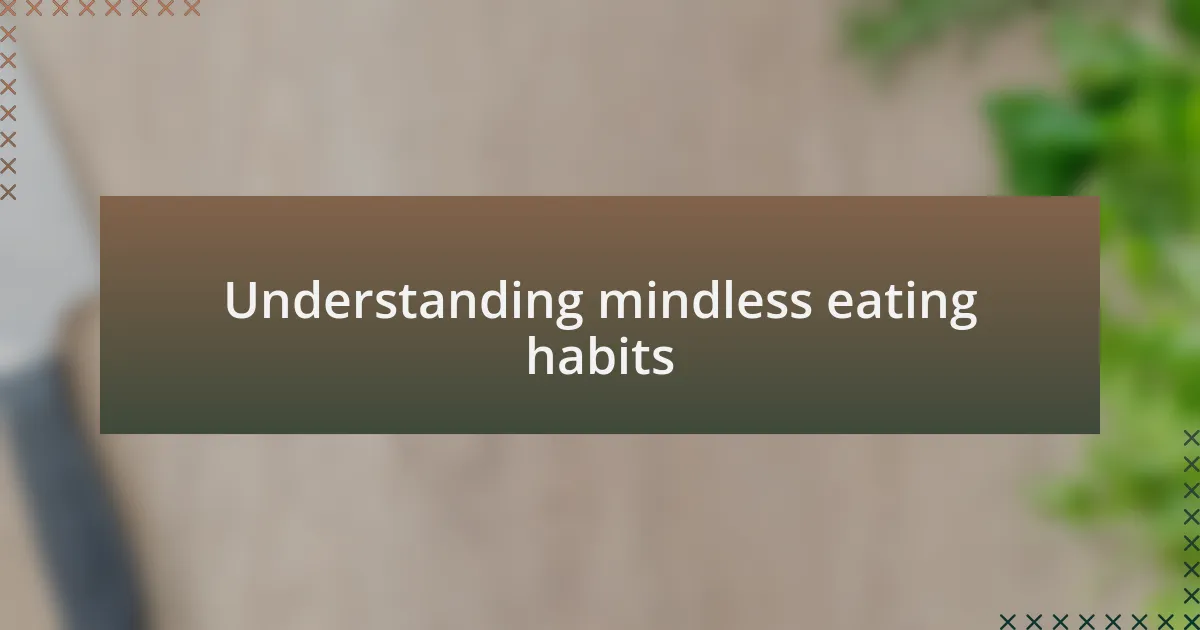
Understanding mindless eating habits
Mindless eating habits often creep in during moments of distraction or stress. I remember snacking on chips while scrolling through my phone, barely realizing how much I was consuming. It’s astonishing how often we munch absentmindedly, isn’t it?
Many of us fall into routines where food is consumed for reasons beyond hunger, like boredom or habit. I’ve found myself reaching for a piece of chocolate after a long day, not because I was hungry, but because it felt like a reward. It raises a question: how often do we use food as a quick fix for our emotions without even acknowledging it?
These habits can numb our awareness, leading to overeating and feelings of guilt afterward. I’ve experienced that sinking feeling when I finish a bag of popcorn during a movie, only to realize I didn’t truly enjoy any of it. Could tuning into our eating and acknowledging our triggers help us break this cycle? Exploring these patterns with curiosity rather than judgment can be the first step toward mindful eating.
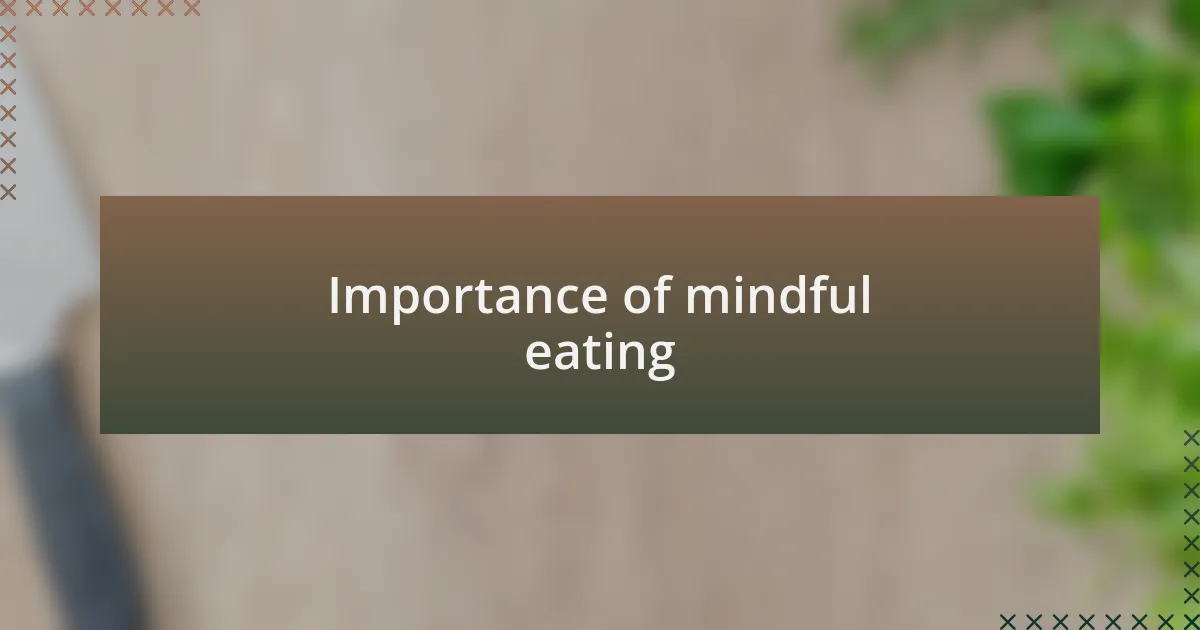
Importance of mindful eating
Mindful eating is essential for cultivating a healthier relationship with food. I recall a time when I savored a juicy slice of watermelon at a picnic. Each bite was a burst of sweetness that completely drew me in; I felt its texture, enjoyed its coolness, and truly appreciated the experience. This level of awareness not only made the food more satisfying but also helped me pause and connect with my body’s hunger signals.
When I started practicing mindful eating, I found that it significantly reduced my cravings for unhealthy snacks. In moments of focus, like when I deliberately chewed a piece of dark chocolate, I noticed how satisfying it could be. It’s curious how slowing down transforms the experience—what might seem like a small adjustment can have profound implications. Why do we rush through meals when they can be such an enjoyable moment in our day?
Additionally, being mindful while eating can promote more balanced choices. I’ve noticed that when I’m present at the moment, I’m less likely to opt for quick-fix comfort foods that often don’t nourish my body. Engaging with my meals in this way helps me make decisions based on my true needs rather than fleeting desires. Could this shift in perspective lead us to discover new favorites that genuinely satisfy our cravings?
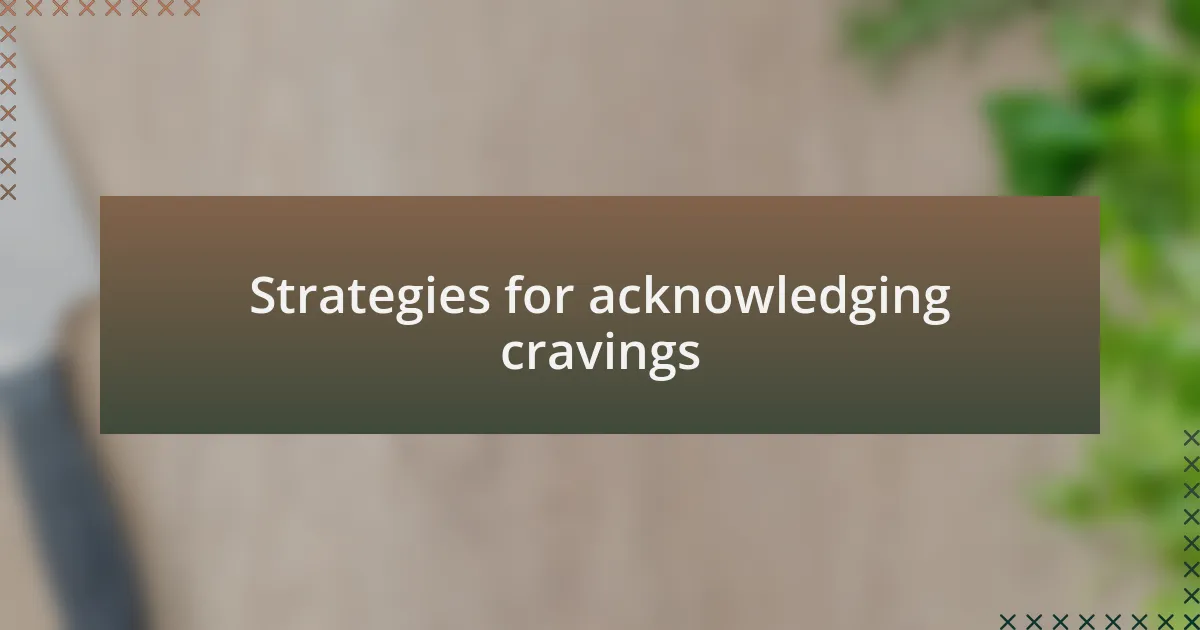
Strategies for acknowledging cravings
When cravings hit, I find it helpful to pause and take a breath. Recently, when I was tempted by a bag of chips, I sat down instead, closed my eyes briefly, and asked myself what I was really craving. Was it the salt and crunch, or was I actually seeking comfort after a long day? Allowing myself to ask these questions helped clarify my true desire, leading me to opt for celery sticks with hummus instead, which satisfied both my need for crunch and a healthier choice.
Another strategy I’ve embraced is writing down my cravings in a journal. A few weeks ago, I noted that I often craved something sweet in the afternoons. By simply acknowledging this pattern, I began to manage it better. I started pairing my cravings with healthier alternatives—like Greek yogurt with honey—and soon discovered that the act of writing not only validated my feelings but also guided me toward mindful choices. Isn’t it interesting how awareness alone can shift our actions?
Finally, I sometimes play a little game with myself before indulging in a craving. I ask, “Can I wait ten minutes?” During that time, I focus on a different activity, whether it’s reading or taking a quick walk. More often than not, I find that the urge passes, or I end up needing less of the food than I initially thought. This simple tactic transforms the craving from a urgent need into a manageable thought, giving me a sense of control. How often might we discover that we don’t need to act on every craving?
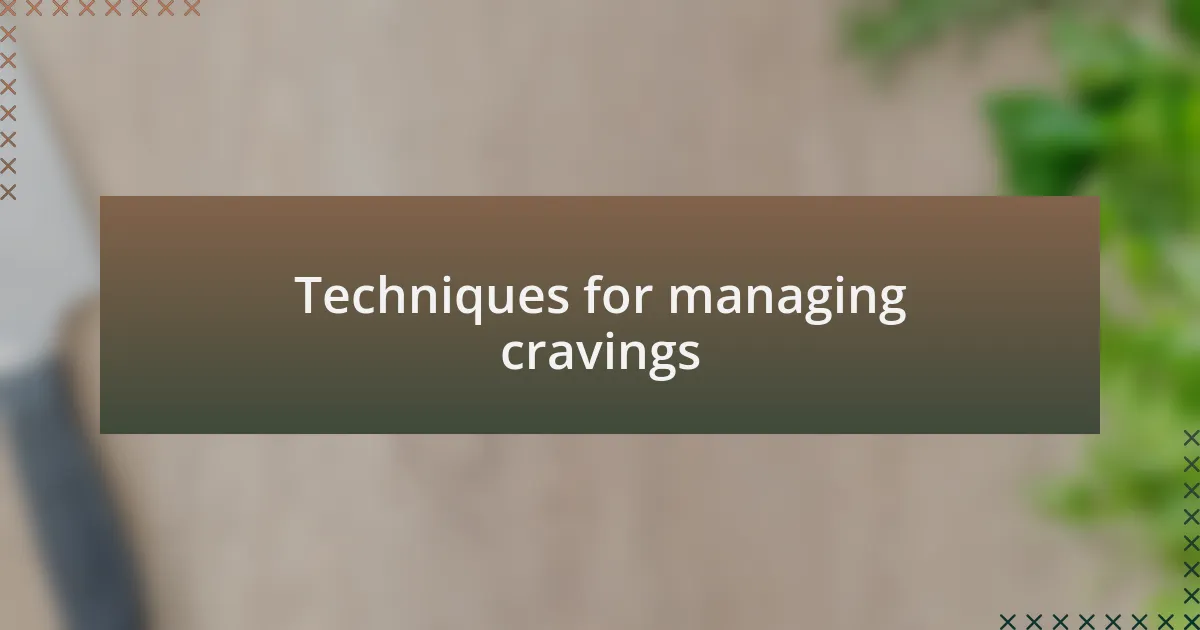
Techniques for managing cravings
One technique that I’ve found particularly effective is mindful eating. The last time I gave in to a craving for chocolate, I decided to really savor each bite instead of scarfing it down mindlessly. By taking my time, focusing on the flavors and textures, I noticed that just a small piece was enough to satisfy me. Have you ever experienced that moment of realization when you taste something deeply and realize it’s more fulfilling than you thought?
I also incorporate herbal teas into my craving management. I remember one afternoon when the desire for a sugary snack was overwhelming. Instead of reaching for cookies, I brewed a cup of peppermint tea. The warmth and aroma distracted my mind, and the act of sipping slowly allowed me to reconnect with my body’s signals. It’s amazing how a simple shift in what we choose to consume can steer away those stubborn cravings.
Finally, I practice gratitude as a way to shift my focus. Recently, when I felt the pull toward a heavier meal, I took a moment to think about all the nourishing foods I had enjoyed that week. Reflecting on how good I felt after eating fresh fruits and vegetables reminded me that I could prioritize my health over momentary indulgences. Have you ever considered how gratitude could help you make healthier choices in those craving moments?
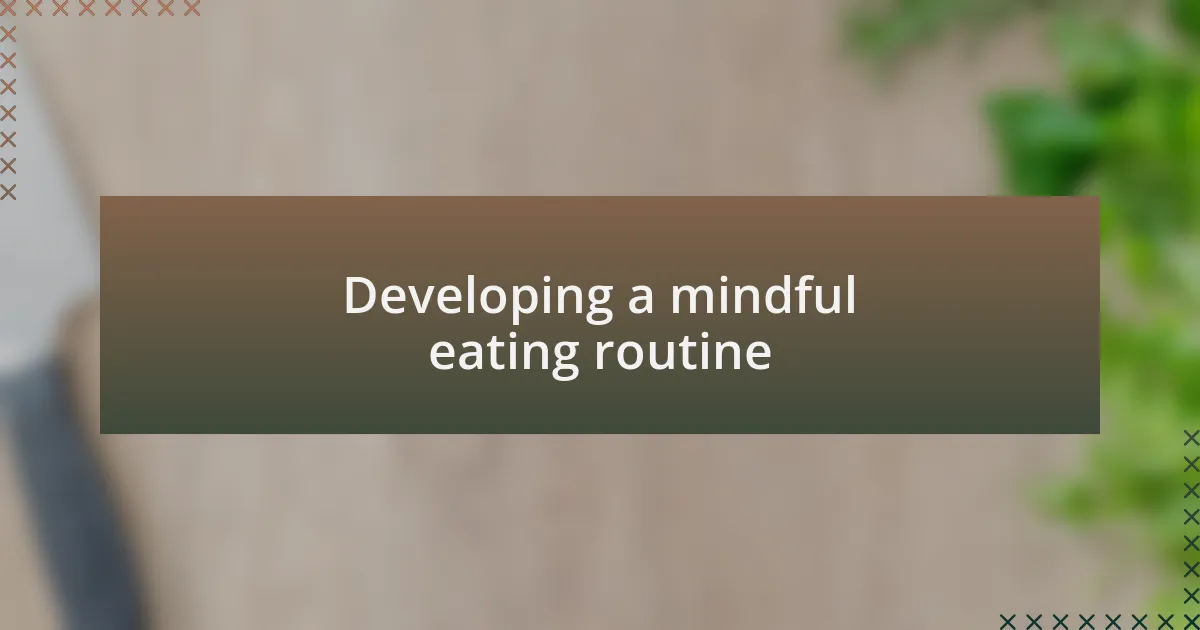
Developing a mindful eating routine
Developing a mindful eating routine begins with creating an environment that encourages presence. I recall one evening when I set the table with my favorite cloth and lit a candle, transforming my simple dinner into a sensory experience. That intentional act helped me focus on my meal, allowing me to appreciate each flavor and texture fully. Have you ever noticed how setting the mood can enhance your dining experience?
In addition to setting the scene, timing plays a crucial role in mindful eating. I like to choose specific times during the day where I can dedicate a few minutes solely to my meal, free from distractions. On one particularly hectic day, I made a conscious choice to pause and enjoy lunch without any screens around me. It was enlightening to realize how much I had rushed through meals in the past. Isn’t it interesting how a small adjustment can lead to a deeper connection with our food?
Lastly, I find that journaling about my meals fosters mindfulness and reflection. After dinner one night, I took a moment to jot down how the food made me feel—both physically and emotionally. Writing about the warmth of a nourishing soup I had made reminded me of the comfort in cooking and savoring my meals. Have you ever thought about how documenting your food experiences could elevate your awareness around eating?
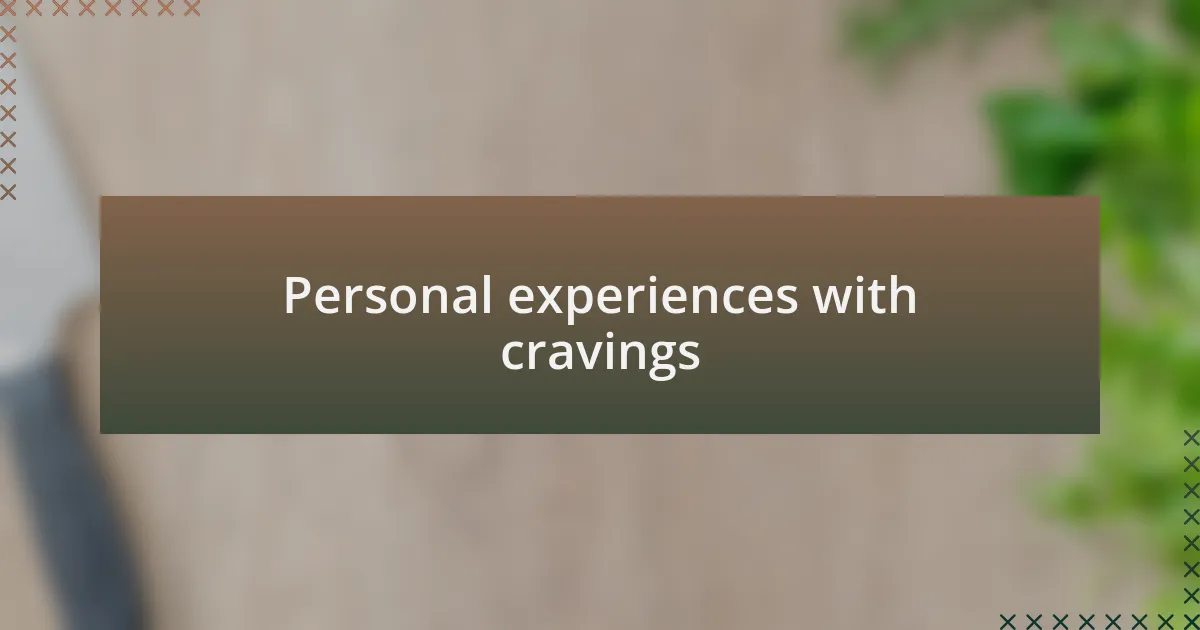
Personal experiences with cravings
Experiencing cravings is something I’ve come to understand on a deeper level over the years. There was a time when I would indulge in a late-night snack without thinking twice about it. One evening, while mindlessly reaching for some chips, I paused. Why was I craving them? I realized it wasn’t hunger I felt, but rather a need for comfort after a long day.
Reflecting on that moment, I learned to embrace my cravings as signals rather than demands. There was a particular day when the urge for chocolate hit me hard. Instead of succumbing to it blindly, I decided to sit with that feeling. I brewed a cup of herbal tea and allowed myself to enjoy the aroma while contemplating my choice. That practice taught me the beauty of self-awareness and decision-making regarding cravings.
I often share how cravings can be an invitation to explore what we genuinely need. On another occasion, I found myself yearning for something crunchy. Instead of reaching for cookies, I opted for baby carrots with hummus. The satisfaction I felt from choosing a healthier option was profound. Have you ever discovered that listening to your body leads to surprising, and sometimes healthier, choices?
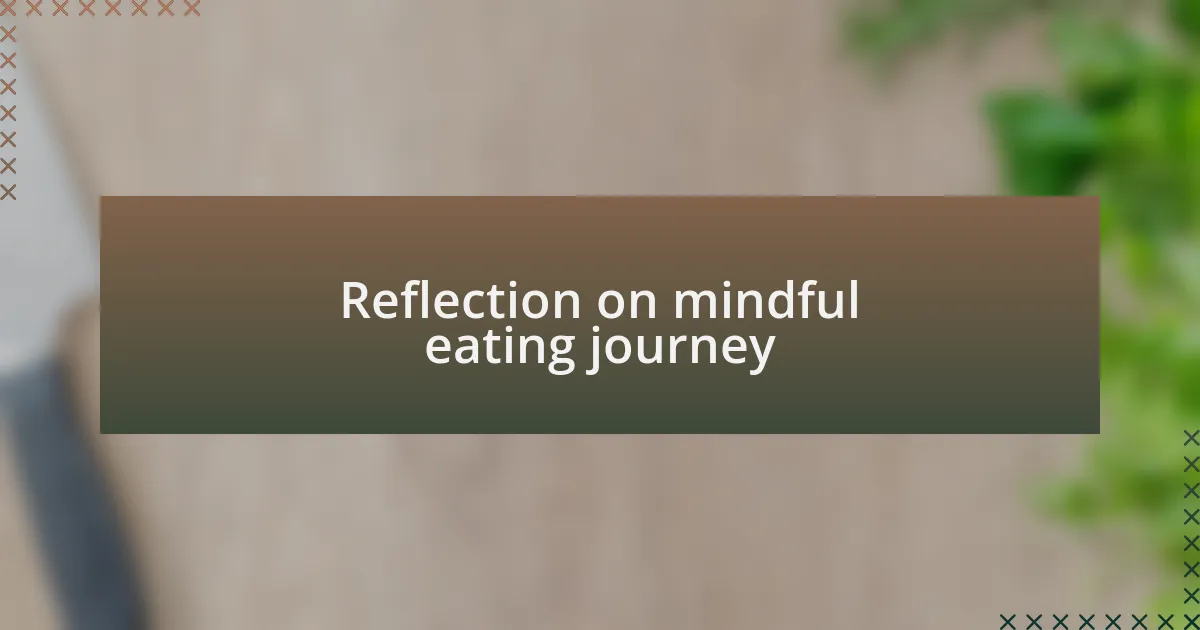
Reflection on mindful eating journey
As I navigate my mindful eating journey, I’ve encountered moments that challenge my preconceived notions about cravings. There was a Sunday afternoon when I felt an overwhelming urge for ice cream. Instead of giving in right away, I took a pause and considered what I truly craved—was it the ice cream itself or the nostalgia of hot summer days spent with friends? That reflection helped me realize that sometimes my cravings point to a deeper emotional need, prompting me to seek connection rather than just food.
On another occasion, I was hit with a sudden desire for salty snacks while working late. Rather than munching mindlessly, I decided to take a short walk. During those few minutes, I reflected on my day and acknowledged my tiredness, which became a more pressing need than the snack itself. This experience highlighted how mindfulness can transform a craving into an opportunity for self-care and reflection. Isn’t it fascinating how a simple shift in perspective can lead to more fulfilling choices?
Over time, I’ve discovered the power of journaling my cravings. One week, after logging my feelings each day, I noticed a pattern: I craved sweets after long, stressful meetings. Recognizing this, I began preparing nutritious desserts to enjoy afterward, feeling both satisfied and proud of my choices. It’s remarkable how understanding the emotional layers of cravings allows for more intentional and joyful eating habits. How have your cravings opened doors to deeper insights in your own life?